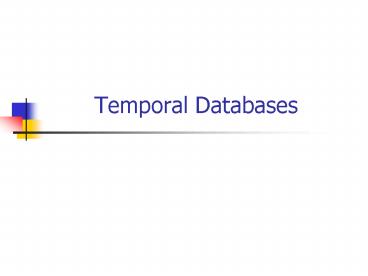Temporal Databases - PowerPoint PPT Presentation
1 / 21
Title: Temporal Databases
1
Temporal Databases
2
Outline
- Spatial Databases
- Indexing, Query processing
- Temporal Databases
- Spatio-temporal
- .
3
Temporal DBs Motivation
- Conventional databases represent the state of an
enterprise at a single moment of time - Many applications need information about the past
- Financial (payroll)
- Medical (patient history)
- Government
- Temporal DBs a system that manages time varying
data
4
Comparison
- Conventional DBs
- Evolve through transactions from one state to the
next - Changes are viewed as modifications to the state
- No information about the past
- Snapshot of the enterprise
- Temporal DBs
- Maintain historical information
- Changes are viewed as additions to the
information stored in the database - Incorporate notion of time in the system
- Efficient access to past states
5
Temporal Databases
- Temporal Data Models extension of relational
model by adding temporal attributes to each
relation - Temporal Query Languages TQUEL, SQL3
- Temporal Indexing Methods and Query Processing
6
Taxonomy of time
- Transaction time databases
- Transaction time is the time when a fact is
stored in the database - Valid time databases
- Valid time is the time that a fact becomes
effective in reality - Bi-temporal databases
- Support both notions of time
7
Example
- Sales example data about sales are stored at the
end of the day - Transaction time is different than valid time
- Valid time can refer to the future also!
- Credit card 03/01-04/06
8
Transaction Time DBs
- Time evolves discretely, usually is associated
with the transaction number - A record R is extended with an interval t.start,
t.end). When we insert an object at t1 the
temporal attributes are updated -gt t1, now) - Updates can be made only to the current state!
- Past cannot be changed
- Rollback characteristics
T1 -gt T2 -gt T3 -gt T4 .
9
Transaction Time DBs
- Deletion is logical (never physical deletions!)
- When an object is deleted at t2, its temporal
attribute changes from t1, now) ? t1, t2) (i.e.
it updates its interval) - Object is alive from insertion to deletion
time, ex. t1 to t2. If the value is now then
the object is still alive
time
10
Transaction Time DBs
id
Database evolves through insertions and deletions
11
Transaction Time DBs
- Requirements for index methods
- Store past logical states
- Support addition/deletion/modification changes on
the objects of the current state - Efficiently access and query any database state
12
Transaction Time DBs
- Queries
- Timestamp (timeslice) queries ex. Give me all
employees at 05/94 - Range-timeslice Find all employees with id
between 100 and 200 that worked in the company on
05/94 - Interval (period) queries Find all employees
with id in 100,200 from 05/94 to 06/96
13
Valid Time DBs
- Time evolves continuously
- Each object is a line segment representing its
time span (eg. Credit card valid time) - Support full operations on interval data
- Deletion at any time
- Insertion at any time
- Value change (modification) at any time (no
ordering)
14
Valid Time DBs
- Deletion is physical
- No way to know about the previous states of
intervals - The notion of future, present and past is
relative to a certain timestamp t
15
Valid Time DBs
The reality best know now !
16
Valid Time DBs
- Requirements for an Index method
- Store the latest collection of interval-objects
- Support add/del/mod changes to this collection
- Efficiently query the intervals in the collection
- Timestamp query
- Interval (period) query
17
Bitemporal DBs
- A transaction-time Database, but each record is
an interval (plus the other attributes of the
record) - Keeping the evolution of a dynamic collection of
interval-objects - At each timestamp, it is a valid time database
18
Bitemporal DBs
19
Bitemporal DBs
- Requirements for access methods
- Store past/logical states of collections of
objects - Support add/del/mod of interval objects of the
current logical state - Efficient query answering
20
Temporal Indexing
- Straight-forward approaches
- B-tree and R-tree
- Problems?
- Transaction time
- Snapshot Index, TSB-tree, MVB-tree, MVAS
- Valid time
- Interval structures Segment tree, even R-tree
- Bitemporal
- Bitemporal R-tree
21
Temporal Indexing
- Lower bound on answering timeslice and
range-timeslace queries - Space O(n/B), search O(logBn s/B)
- n number of changes, s answer size, B page
capacity

